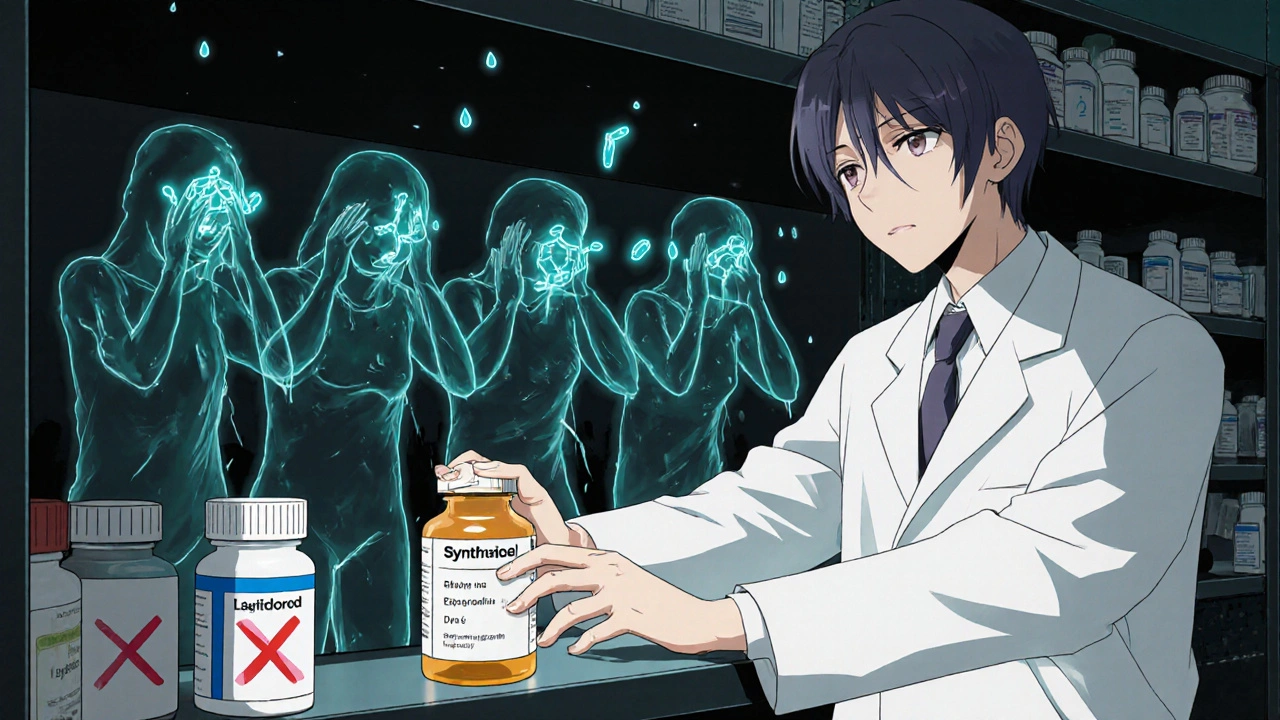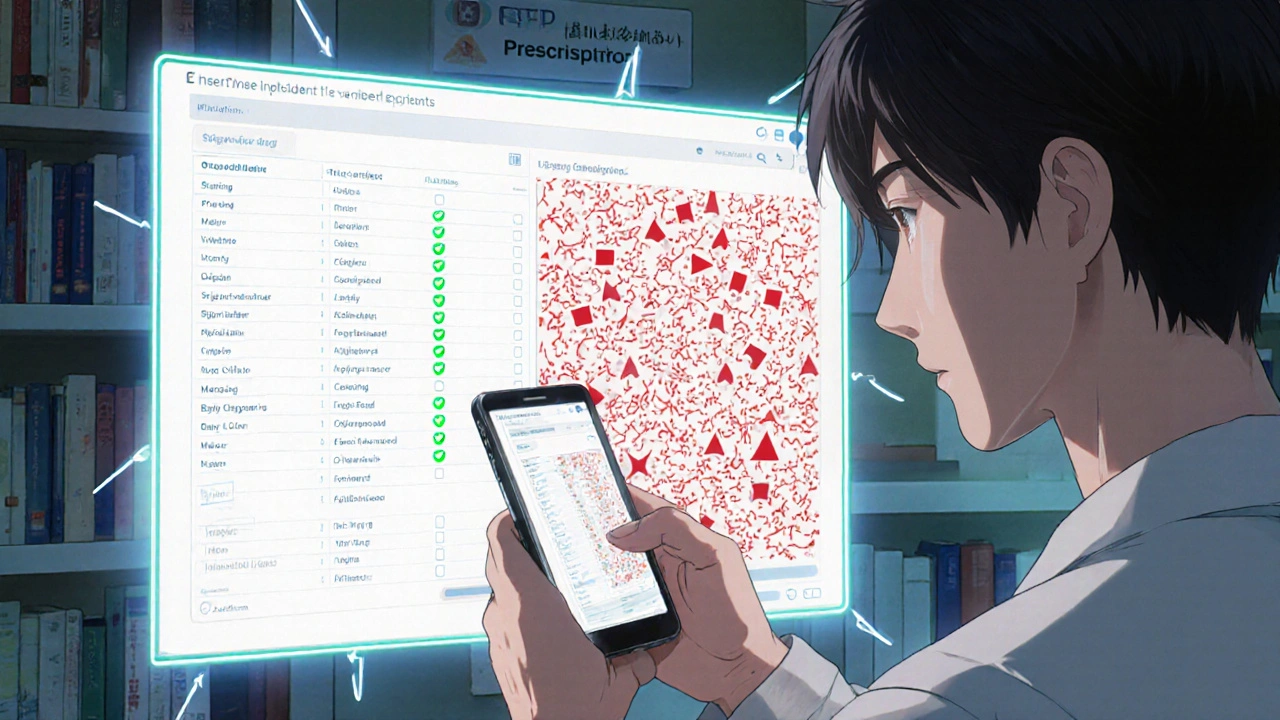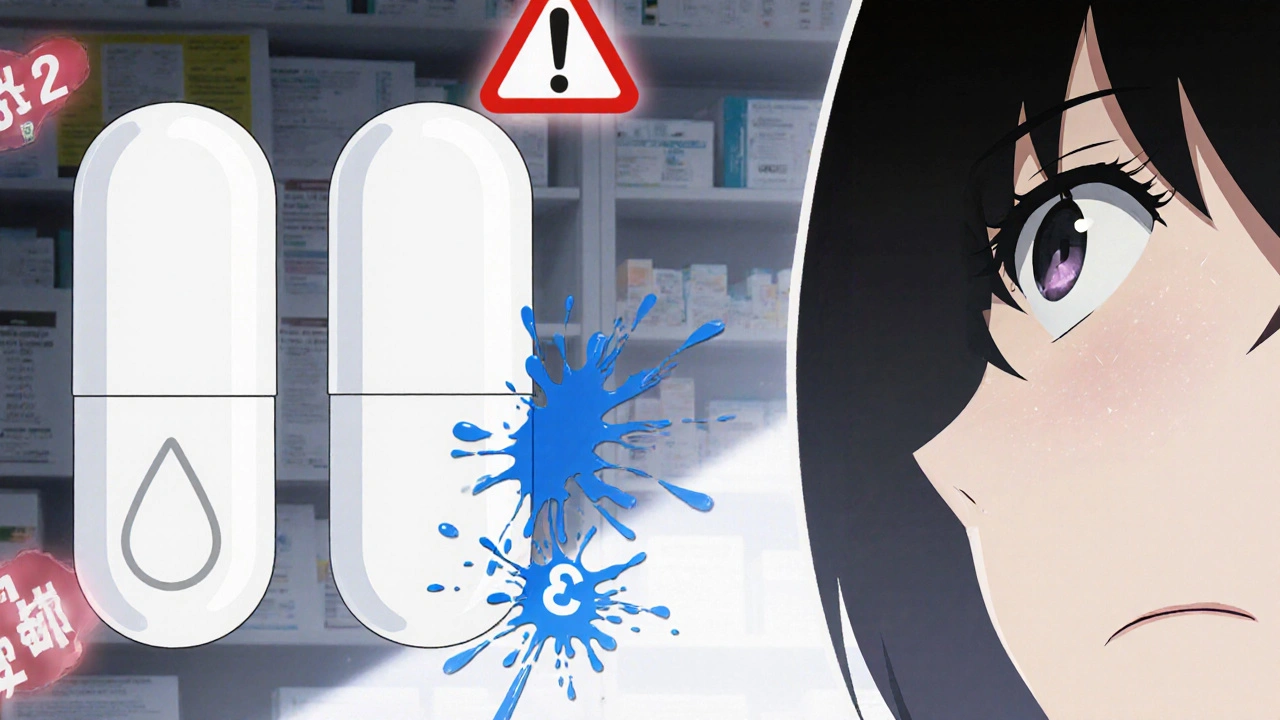When you pick up a generic pill, you assume it’s the same as the brand-name version. Same active ingredient. Same effect. Same price. But what you don’t see - what’s hidden in the tablet or capsule - might be the reason you feel worse after switching.
Those white powders, coatings, and fillers? They’re called excipients. And while they don’t treat your condition, they can trigger bloating, rashes, stomach cramps, or even full-blown allergic reactions. For many people, the problem isn’t the drug - it’s what’s holding it together.
What Are Excipients, Really?
Excipients are the non-active parts of a medicine. They don’t cure your high blood pressure or thyroid issue. But they do everything else: make the pill easy to swallow, keep it from falling apart, help it dissolve in your gut, or even make it taste less bitter. Common ones include lactose (a milk sugar), magnesium stearate (a lubricant), croscarmellose sodium (a disintegrant), and artificial colors like FD&C Blue #2 or Yellow #5.
Here’s the catch: every generic version of the same drug can have a completely different mix of these ingredients. Two pills with the same 50 mg of levothyroxine? They might look identical, but one could have lactose, and the other might use starch. One might have a dye that triggers a reaction. Another might use a preservative that causes stomach upset.
The U.S. Food and Drug Administration (FDA) says excipients are "inactive." But that’s misleading. A 2019 study from Brigham and Women’s Hospital and MIT analyzed over 42,000 oral medications and found that 90.2% of them contained at least one ingredient linked to adverse reactions in sensitive people. The average pill had 8.8 excipients. That’s not harmless filler - that’s a chemical cocktail.
Why Switching Generics Can Make You Sick
Generics are cheaper because they don’t need to repeat expensive clinical trials. The FDA only requires them to prove they deliver the same amount of active drug into your bloodstream as the brand-name version. That’s called bioequivalence - and it’s measured within a narrow range: 80% to 125% of the original.
But bioequivalence doesn’t mean identical. It doesn’t check how your body reacts to the fillers. So when your pharmacist switches your Synthroid from one generic to another - maybe because your insurance changed or the cheaper version came in - you might start feeling nauseous, bloated, or anxious. You might think it’s your condition worsening. But it could be the new tablet’s dye or lactose content.
One patient on Reddit shared: "Switched from brand Synthroid to generic. Within two days, I had severe diarrhea and cramps. Turned out the generic had FD&C Blue #2. I’m allergic to it. My doctor didn’t even know it was in there."
A 2021 survey of pharmacists found that 73.5% had patients report symptoms they believed were tied to excipient changes after switching generics. And it’s not just anecdotal. The FDA’s own adverse event reports from 2018 to 2022 documented cases of "dose dumping" - where a bad excipient caused the drug to release too fast, leading to overdose-like symptoms.
The Lactose Problem
Lactose is in 40-60% of all oral solid medications, according to DrugPatentWatch. That’s about half the pills you’ll ever take. For someone with lactose intolerance, even a tiny amount - as little as 1 gram - can cause bloating, gas, and diarrhea. Most people think they can handle a little lactose. But in a pill, that’s not a splash of milk in coffee. It’s concentrated, swallowed daily, and your gut doesn’t have time to adjust.
One study found that 65-70% of lactose-intolerant patients experienced symptoms when taking daily medications containing more than 12 grams of lactose. But sensitive individuals reacted to just 1-2 grams. That’s the amount found in a single tablet. So if you’re on three pills a day, you could be consuming 3-6 grams - enough to trigger symptoms even if you’ve never had trouble with dairy.
And here’s the kicker: most generic manufacturers don’t list lactose on the bottle. You have to dig into the FDA’s Inactive Ingredient Database or call the manufacturer. Your pharmacist might not even know.

Colors, Preservatives, and Other Hidden Triggers
Artificial colors are another big offender. Yellow #5 (tartrazine) and Blue #1 are common in pediatric and branded versions - but also sneak into generics. People with asthma or hives often react to these dyes. Parabens, used as preservatives, can irritate the skin or gut. Sulfites, found in some injectables and liquids, can trigger asthma attacks.
And it’s not just allergies. Some excipients interfere with absorption. A solubilizer that works in one brand might not work the same in another. That means your body might not absorb enough of the drug - making it feel like the medication isn’t working. You might think your blood pressure is out of control, but the real issue is the excipient changed how the pill broke down in your stomach.
What You Can Do: A Practical Guide
You don’t have to suffer silently. Here’s how to take control:
- Track your symptoms. Did your bloating start after switching pills? Did your rash appear after a new prescription? Write it down. Note the name of the drug, the manufacturer, and the date you switched.
- Check the ingredients. Use the FDA’s Inactive Ingredient Database or the Pillbox tool from the National Library of Medicine. Type in the drug name and manufacturer. You’ll see every excipient listed.
- Ask your pharmacist. Don’t assume they know. Ask: "Does this generic have lactose? Artificial colors? Parabens?" If they don’t know, ask them to look it up. Pharmacists spend an average of 7 minutes per patient researching these issues - they’re trained to do it.
- Request a specific version. If one generic works and another doesn’t, ask your doctor to write "dispense as written" or "no substitutions" on the prescription. You’re allowed to do this.
- Document your intolerance. If you react to an excipient, tell your doctor. Ask them to note it in your chart. Some providers will switch you to a brand-name drug. Others will find a different generic without the trigger.

Who’s Most at Risk?
Not everyone reacts. But some groups are far more vulnerable:
- People with known food allergies or intolerances (lactose, gluten, sulfites)
- Those with chronic digestive disorders (IBS, Crohn’s, celiac)
- Pediatric and elderly patients - their bodies process excipients differently
- People on multiple daily medications - more excipients = higher cumulative exposure
- Patients with autoimmune conditions or mast cell disorders
Neurology patients - those on epilepsy or Parkinson’s meds - are especially at risk. Small changes in absorption can mean the difference between seizure control and a crisis. That’s why some neurologists refuse to switch generics unless they’re certain the excipients match.
The Bigger Picture: Change Is Coming
The pharmaceutical industry is waking up. In 2023, the FDA launched the Excipient Safety Modernization Initiative to update its database with real patient reports. MIT developed an AI tool that predicts excipient tolerance based on genetics. The European Pharmacopoeia is adding 17 new safety thresholds in 2024. By 2025, the FDA plans to require full excipient disclosure in electronic prescriptions.
Companies are already responding. Specialty formulations - lactose-free, dye-free, gluten-free generics - are a $18.7 billion market, growing fast. Over 40% of big pharma companies now track excipient sensitivity data internally. And 78% of hospitals have protocols for managing these reactions.
But until then, you’re the frontline defense. The system isn’t designed to warn you. So you have to ask. You have to check. You have to speak up.
Final Thought: "Inactive" Doesn’t Mean Harmless
Just because an ingredient doesn’t treat your disease doesn’t mean it’s safe for you. The assumption that excipients are universally harmless is outdated - and dangerous. Thousands of people experience real side effects every year because no one told them to look beyond the active ingredient.
Your health isn’t just about what the pill fixes. It’s about what the pill is made of. And if you’re feeling off after a switch, it might not be your condition. It might be the filler.
Are generic drugs always safe if they have the same active ingredient?
No. While generics must deliver the same amount of active drug into your bloodstream, they can contain completely different inactive ingredients. These excipients can cause allergic reactions, digestive issues, or affect how the drug is absorbed. Two pills with the same levothyroxine or metformin can have different fillers, dyes, or preservatives - and that can change how you feel.
Can lactose in pills cause problems even if I’m not allergic to milk?
Yes. Lactose intolerance isn’t an allergy - it’s a digestive issue. Your body lacks the enzyme to break it down. Even small amounts - as little as 1 gram - can trigger bloating, gas, cramps, or diarrhea in sensitive people. Many pills contain 5-10 grams of lactose per dose. If you’re on three pills a day, that’s 15-30 grams - enough to cause symptoms even if you handle dairy fine.
How do I find out what excipients are in my generic medication?
Check the FDA’s Inactive Ingredient Database or use the Pillbox tool from the National Library of Medicine. Enter the drug name and manufacturer. You can also ask your pharmacist to look it up - they have access to manufacturer data. Don’t rely on the bottle label; generics often don’t list all excipients clearly.
Can I ask my doctor to prescribe a brand-name drug instead of a generic?
Yes. If you’ve had a reaction to a generic, tell your doctor. They can write "dispense as written" or "no substitutions" on the prescription. Insurance may require prior authorization, but if you have documented intolerance - especially with a doctor’s note - many will approve the brand-name version.
Are there generic drugs without lactose or artificial colors?
Yes. Many manufacturers now offer lactose-free, dye-free, and gluten-free versions of common drugs. These are often labeled as "specialty generics" and are growing in availability. Ask your pharmacist for options. You may pay slightly more, but if you’ve had reactions, it’s worth it.
Why don’t pharmacists always warn me about excipients?
Many pharmacists aren’t trained to routinely check excipients unless a patient asks. The system focuses on active ingredients and dosage. But as awareness grows, more pharmacists are learning to flag potential issues. Don’t wait for them to bring it up - ask. It’s your right to know what’s in your medicine.
What should I do if I think an excipient is making me sick?
Stop the medication if symptoms are severe. Contact your doctor. Keep a log of symptoms, the drug name, manufacturer, and when you started it. Request the ingredient list from the manufacturer or FDA database. Ask your doctor to document your intolerance in your medical record. This helps prevent future switches to the same problematic version.

Riohlo (Or Rio) Marie
November 17, 2025 AT 13:16Oh honey, you just described my entire pharmaceutical nightmare. I switched from brand Synthroid to a generic and spent three weeks feeling like a bloated, anxious ghost. Turns out? FD&C Blue #2. I didn’t even know dyes were in pills. My doctor acted like I was complaining about the color of the packaging. I had to dig through the FDA database like some kind of pharmaceutical detective. And now? I refuse to take anything without a full excipient audit. It’s not paranoia - it’s survival.
Conor McNamara
November 19, 2025 AT 05:26so i think this is all part of the big pharma plan to make us sick so they can sell us more drugs. they dont want us to know about excipients because if we did we might stop buying. and dont get me started on how the fda is in the pocket of the corporations. i read this one forum post from a guy in canada who said his pills had microplastics. i dont know if its true but its possible. the system is rigged.
steffi walsh
November 20, 2025 AT 01:28OMG I’ve been there!! I thought I was just ‘getting older’ and my digestion was going haywire… until I switched generics and boom - bloating, cramps, the whole deal. I checked the FDA database and found lactose in three different pills I was on. Now I only take the ones labeled ‘lactose-free’ and my energy is back. You’re not crazy - your body is just telling you the truth. Ask your pharmacist - they’ll help you if you ask nicely 😊
Leilani O'Neill
November 20, 2025 AT 10:35How is it even legal to put allergens in medicine without labeling them properly? This is negligence disguised as regulation. In Ireland, we have better standards - you’d never see this level of corporate indifference here. Americans just accept being treated like lab rats. The fact that you have to Google your own pill’s ingredients to avoid poisoning yourself is a national disgrace.
Sarah Frey
November 21, 2025 AT 10:17Thank you for this incredibly thorough and important post. As a healthcare professional, I see patients every week who attribute their symptoms to their underlying condition when the real culprit is an excipient they never knew about. The FDA’s definition of ‘inactive’ is dangerously outdated. I’ve started including excipient screening in my patient intake forms. Knowledge is power - and in this case, it’s also health.
Katelyn Sykes
November 22, 2025 AT 01:48I had a patient last week who had been on a generic for 2 years and suddenly developed hives. Turns out the manufacturer changed the dye. She thought it was her stress or new laundry detergent. Took her 6 months to connect the dots. If you’re feeling weird after a switch - don’t ignore it. Write it down. Show your doctor. You’re not overreacting. Your body is giving you data. Listen.
Gabe Solack
November 23, 2025 AT 13:51Just had to share this - I asked my pharmacist about lactose in my metformin. She pulled up the manufacturer’s spec sheet and said, ‘Oh yeah, this one’s lactose-free, but the other one isn’t.’ I had no idea. We’re talking about a $4 pill. No one’s checking this stuff. But now I always ask. And I’ve started using the Pillbox app. It’s saved me from two bad switches. 🙌
Kristi Joy
November 25, 2025 AT 12:58To anyone reading this and thinking ‘I’m fine’ - please don’t assume that. I’m a nurse who’s seen people suffer silently for years because no one told them to look beyond the active ingredient. If you’ve ever felt ‘off’ after a switch, you’re not alone. You’re not imagining it. You’re not weak. You’re just someone who’s paying attention. Keep asking. Keep documenting. And if you need help navigating the FDA database - DM me. I’ve got templates. You don’t have to do this alone.